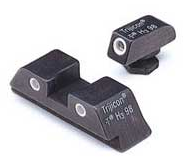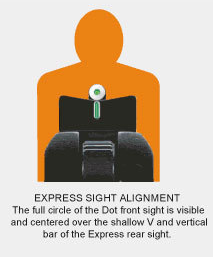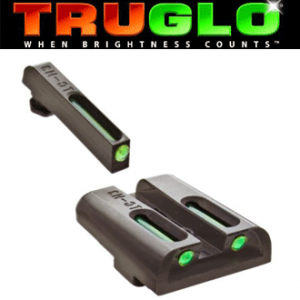A student called to ask what my thoughts were related to sights for a home defense pistol. He asked what I thought about tritium night sights, fiber optic sights, and gold bead sights for his pistol. He planned to equip the pistol with a rail mounted light, which can be a very useful tool (see post on weapon mounted lights). Fiber optic and brass dot sights are designed for competition shooting, which is traditionally held in a bright environment, though occasionally, there are low light defensive pistol matches.

For a defensive pistol, it is hard to beat tritium sights. Small, tritium inserts which glow in the dark, help an armed officer or law abiding citizen acquire their sights under reduced light and no light conditions. Clearly there are situations where a person will not use their sights (instinctive shooting), but tritium sights give you an option that traditional sights do not. Made by several manufacturers, the two brands of tritium sights that I prefer are the Heinie Straight Eight LEDGE sight and the XS 24/7 Express Sights.

Richard Heinie makes some of the best sights on the market. They are high quality, precise sights and are worth the money. Having carried various pistols over the years, I‘m familiar with the traditional Trijicon tritium 3-dot sight. This sight requires the shooter to line up the 3 tritium lamps horizontally with the front sight dot between the two rear dots. These sights work fine and are very common. The Heinie Straight Eight is a vertical sight. There are only two tritium lamps in this design. The shooter “stacks” the two dots to line them up, giving the appearance of an “8”, hence the name “Straight Eight”. Heinie builds excellent target sights; the Straight Eight night sights are high quality target sights that have tritium inserts added. Additionally, sharp edges that are common to match sights are not present on Heinie defensive sights. This allows the shooter to quickly load, reload, and clear stoppages without the added risk of injury to the support hand.

Similar to the Heinie Straight Eights, the XS Sights 24/7 Express Sights utilize a vertical sight alignment. The Express Sights incorporate a “Big Dot” Tritium or “Standard Dot” Tritium front sight with a vertical tritium “post”. This is one of the best “flash” sights on the market for day light engagements, and an excellent setup for low light environments. The Express sight also offers a low profile, snag-free design that reduces the likelihood of injuring the support hand, while allowing the shooter to use the rear sight as a slide-racker during incapacitation drills/incidents. Personally, I prefer the “regular” dot to the “Big” dot, but that is simply my preference.

One additional sight that I wanted to mention is the Truglo TFO or Tritium Fiber Optic Sight. Years ago when fiber optic sights first hit the market, I put a set on a Glock 22 that I used for IDPA. I loved how quickly I could acquire those sights. They weren’t quite as accurate as I wanted, but they were fast for the 5-10 yard scenarios. My daily carry pistol back then was a Glock 23. I had factory Glock Trijicon tritium night sights on it which were fine in low light, but I wanted the same “glow” that I had at night, during the day. I discovered the TFO sights and quickly bought a set and mounted them to my G23. They took a bit of getting used to, but they turned out to be good all-day sights. The only drawback was the length of the front sight. The design of the sight put a fiber optic rod in front of a tritium lamp. During normal light the fiber optic rod would glow from ambient light. During low light conditions it would transmit the tritium glow. The issue was that the front sight was nearly an inch long, which meant that the effective sight radius was reduced by nearly an inch. On a Glock 23 that’s almost a 20 percent reduction in sight radius, which equates to a less accurate pistol. This is simply a tradeoff. You are trading the ability to shoot a little more accurately in one lighting condition for the ability to acquire your sights faster (or simply acquire them at all) in all lighting conditions. To that end, I like the TFO sights; they serve their purpose well.
In the end, the sight you choose should be one that works well for you. Most factory sights are simple and get the job done, but leave something to be desired. When changing a sight, it is important to have it installed by a competent gunsmith or armorer, and to benchrest the pistol to ensure the sights are zeroed for you. Finally, it is very easy to get caught up in the “equipment race” trying to find that perfect sight that will prevent you from ever missing. Remember most shooters need practice, not new equipment. It takes a lot of work to develop the ability to out-shoot a stock defensive pistol. Invest in good quality equipment and then safely practice with your equipment to develop this life-saving skill.
